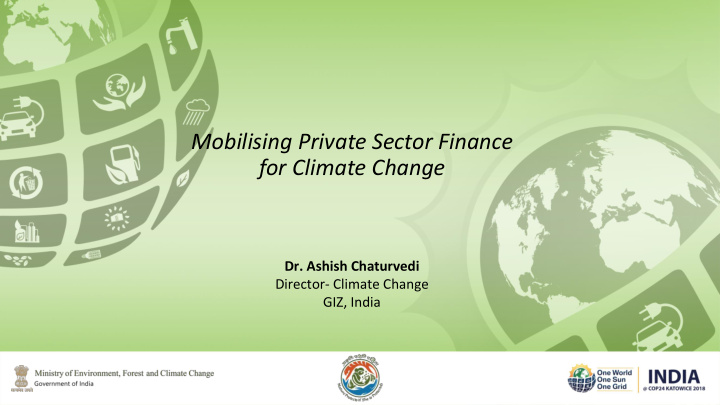



Mobilising Private Sector Finance for Climate Change Dr. Ashish Chaturvedi Director- Climate Change GIZ, India
SAPCC investment plans • Important to Identify various forms, instruments and sources of financing and subsequently develop strategies to target them for financing actions under SAPCCs. • Developed investment plans for SAPCCs of 4 states – Telangana, HP, Punjab, TN. • Methodology developed called ‘Integrated Assessment of Public Financing of State Budget towards SAPCC Implementation’. • Developed case studies - with financial analysis and financing models, serving as demonstrative examples of how the State can finance SAPCC activities. Baseline Assessment Prioritize activities Assess financing needs Develop investment plan Based on SAPCC and Costing of SAPCC for SAPCC Intensive Develop SAPCC other state activities stakeholder investment plan initiatives Identify additional engagement Case studies in specific Use of MCA tool & financing requirements Nodal institution sectors prioritized for stakeholder & innovative financing for SAPCC funding in the state consultation instruments needed
Snapshot Example – Telangana SAPCC Investment plan S.N Activity identified for Potential funding o. developing demonstrative case mechanism Total SAPCC Rq. Budget per Year 79,125.2 studies of investment plans Total Climate Relevant Expenditure- All 32 Grants… 9,167.2 1 Documentation of biodiversity Multilateral/GCF grant with Total Climate Relevant Expenditure- SAPCC Sectors… 8,514.5 Total Climate Negative Expenditure of App Acc… 579.5 including genetic fingerprinting partial financing from Total Climate Negative Expenditure (Non SAPCC… 59.3 central/state schemes Total Climate Negative Expenditure (SAPCC Sectors) 560.4 2 Creation of forests in CAMPA funds along with Total Climate Positive Expenditure of App Acc (Total… 9,746.7 degraded/public lands in and State funds. Private sector Total Climate Positive Expenditure (Non SAPCC… 790.4 Total Climate Positive Expenditure (SAPCC Sectors) 9,074.8 around cities and towns can also be leveraged 0 20,000 40,000 60,000 80,000 3 Construction of STP at ESCO model or issue Green Nakkavagu – 40 MLD bonds Review of existing investment instruments and internal sources 4 Climate resilient upgradation of Majorly state funded, 40% to sewerage management be met through GBs or PS Factors considered during the review investment 5 Promotion of solar rooftop Gross or net metering model scheme in government buildings with private sector Effectiveness of Characteristics of Characteristics new & innovative investment Fiscal condition of existing ML existing state and instruments in of the state &BL funding in central the state or parts 6 Green Skill Development project Multilateral loan with co- the State government of India sources in Telangana financing from centre/state
Strategic Alliances Significant contribution to Enhanced Water Security in water security , climate change India through actions and adaptation and the SDGs by innovations at community, transforming the institutional catchment, state and national and on-ground capacity of levels India water stewardship network • Unique opportunity to leverage corporate commitments to up- Proposed project scale the adoption of water stewardship in India. Partners • Private sector partners committed to implement the AWS Standard • Diageo/United Spirits Limited, with a focus on its distillery in at priority sites (diverse locations) Alwar, Rajasthan and Aurangabad, Maharashtra • Private companies partnership • ITC, with a focus on food facility in Malur, Karnataka and facilitates to improve , incentivise paper mill in Coimbatore, Tamil Nadu and develop responsible water • MARS, with a focus on mint suppliers in Barabanki, Uttar use practices in the identified Pradesh and food facility in Pune, Maharashtra catchment area • GIZ India, AWS and WWF India
Sensitizing Green Startups & Social Enterprises about Voluntary Carbon Markets • Green Startups and Social Enterprises are not able to access voluntary carbon markets due to high transaction cost, carbon credit project development risk and limited capacities. • With help of sensitization workshop by GIZ several start-ups and social enterprises are collectively developing a Gold Standard Programme of Activity (PoA) in municipal solid waste management thus reducing transaction cost and project risk. • Carbon revenue is distributed after deducting certain overhead costs increasing viability and attractiveness for investors.
Conclusions Leveraging the knowledge of governments and Adaptation is highly Private sector is undertaking communities on local emphasized on the Paris projects with adaptation and scenarios can enable private Agreement and can be linked mitigation benefits sector develop more robust to market based mechanisms adaptation strategies Lack of financial resources PPPs or multi-stakeholder including lack of credit facilities, loans and subsidies partnerships can emerge as appear to be key barriers for key instruments for tackling enhancing adaptation climate change finance 12.12.2018 XXX
Recommend
More recommend